If you are looking for a cactus that thrives in humid areas, you will love epiphytic cacti.
They have long trailing stems and leaves that drape from a hanging basket. They do not have spikes and many also produce stunningly beautiful blooms to decorate your indoor space.
Check out the top 20 epiphytic cactus species for your indoor garden.
List of epiphytic cacti
1. Rhipsalis Elliptica
Rhipsalis Elliptica grows on steep slopes or in the hollows of trees, using its impressive roots to fix itself in place. It has segmented branching leaves, which can grow to around 14 inches (35 cm) long.
Its fruits are red, slightly elongated, and about a third of an inch (0.7 cm) in length.
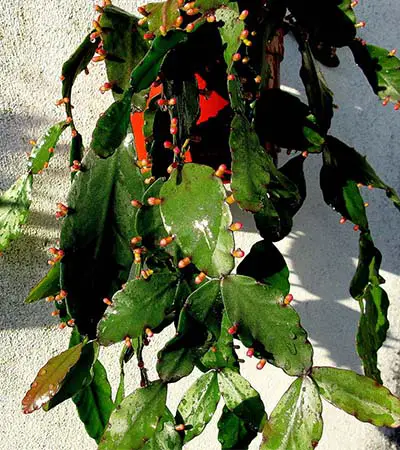
(maria luisa novela, CC BY 2.0, via Wikimedia Commons)
2. Rhipsalis cassutha (Spaghetti Cactus)
This plant hangs its leaves down from the trees in a net of fine strands.
It can reach around 6 feet 6 inches (2 meters) long, and its leaves are narrow and tube-like, similar to spaghetti.
3. Rhipsalis Hoelleri
With its thin, strand-like leaves, Rhipsalis Hoelleri in hanging baskets gives an indoor space a unique, minimalist look.
There are no official estimates for its size, but its tendrils can likely grow at least a few feet long. It produces tiny red flowers.
It is a threatened species.
4. Pfeiffera monacantha
This is a smaller epiphytic cactus, and it produces waxy stems that allow it to retain as much water as possible, as it grows in dry regions attached to tree trunks.
Its stems tend to reach about 1.2 inches (3 cm) wide and 18 inches (45 cm) long.
The fruits are also waxy, and hang down on pendant-like branches.
5. Disocactus flagelliformis (Rattail Cactus)
This cactus branches off in every direction from its base. It gets its roots into a nook in a tree, and gets a good grip before it begins to sprout its long leaves. It also grows quickly, allowing it to spread.
It can reach a spread of almost 5 feet (around 1.5 meters), and may grow up to 3.9 inches (10 cm) tall.
It produces bright purple or red flowers, which can be as big as 3 inches (8 cm) across in diameter.
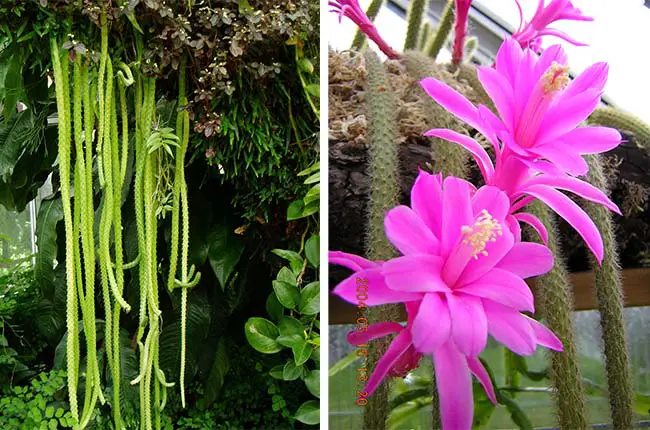
(Magnus Björlin, CC BY-SA 3.0, via Wikimedia Commons)
6. Hatiora herminiae
With a more upright growth structure, Hatiora herminiae is able to nestle into a crevice and then creep up the tree’s trunk.
It can grow up to 1 foot (30 cm) tall, and each individual stem segment may be around 2 inches (5 cm) long.
It produces magenta flowers which are under an inch (2.5 cm) wide across, and deep green, small berries.
7. Selenicereus grandiflorus (Queen of the Night)
This impressive plant can produce huge aerial roots (link), giving it an excellent grip on trees. It grows abundant stems that trail over other plants, and it tends to require support from them.
It can grow to more than 33 feet (10 meters) long and it produces amazing white flowers that only open at night.
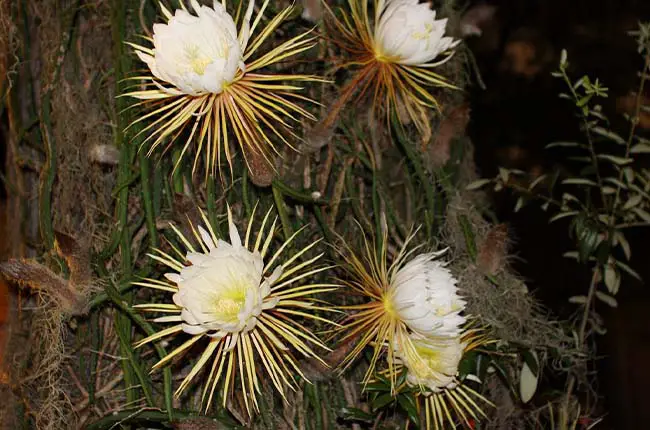
(dafiana from Miami, Florida, United States, CC BY-SA 2.0, via Wikimedia Commons)
8. Lepismium cruciforme (Hurricane Cactus)
The Hurricane Cactus can make a beautiful indoor plant in a hanging basket. It has the ability to anchor its roots in any crevice, with trailing long leaves to capture the sunlight.
Its leaves can reach around 20 inches (50 cm) long, and almost an inch (2 cm) wide. Its flowers vary in color, and its leaves are serrated, and attractive.
9. Lepismium floribundum
Another cactus that wraps its roots firmly around any foothold it can find, the Lepismium floribundum is a fairly recent discovery.
It trails down from trees, allowing its long, dark-green leaves to catch as much sunlight as possible.
It produces an abundance of flowers, and it is able to reach several feet long.
10. Hatiora gaertneri (Easter Cactus)
The Easter Cactus is a popular houseplant treasured for its uniquely shaped leaves and red flowers.
It grows branching stems that are formed of multiple sections, and it can reach about 25 inches (63 cm).
It can be grown in hanging baskets but is also capable of growing on trees and rocks outdoors, with spreading roots that trap moisture and nutrients effectively.
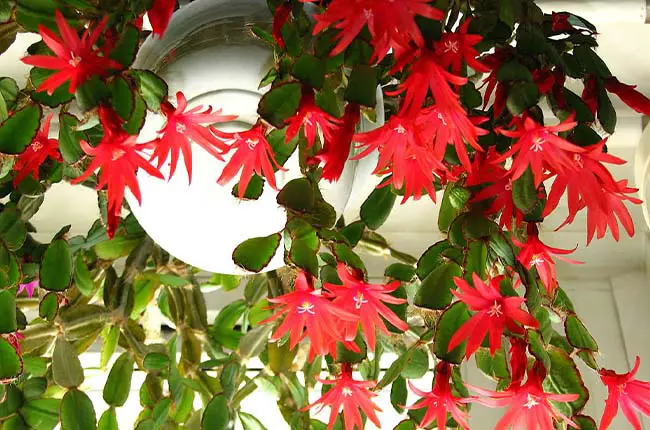
(Kor!An (Андрей Корзун), CC BY-SA 3.0, via Wikimedia Commons)
11. Epiphyllum anguliger (Fishbone Cactus)
The Fishbone Cactus is a popular houseplant for its long, wavy leaves that are uniquely shaped like fishbones.
It can grow to around 6 foot 7 inches (2 meters) long although it doesn’t gain much height.
The flowers are usually creamy white.
12. Epiphyllum oxypetalum (Dutchman’s Pipe Cactus)
Epiphyllum oxypetalum has elongated leaves that stretch out, and a root system perfect for latching onto branches.
It grows lots of leaves from a central point and can reach an astonishing height of 10 feet (3 meters).
Its flowers are a beautiful white color, and its leaves are dark, allowing it to form an attractive and impressive waterfall.
13. Disocactus macranthus
This plant is adapted to shady conditions and grows arched shoots that allow it to trail out into the air. It can easily fit itself into nooks and crannies on trees.
Its notched leaves can grow up to 9 feet (3 meters) long.
It produces flashy yellow blooms and makes a beautiful indoor plant in a hanging basket.
14. Lepismium houlletianum (Snowdrop Cactus)
The Lepismium houlletianum has evolved to hang down from tree branches and capture sunlight. Its roots will catch onto any suitable anchor, holding the plant aloft.
It reaches a size of around 4 foot 11 inches (1.5 meters) at the most, and it was given its common name for its delicate, white bell-shaped flowers, which grow along the joints of its stem.
15. Eccremocactus bradei
This epiphytic cactus has usually broad stems that branch upwards or lean down under their own weight.
Its leaves grow to over 3 feet (1 meter) long and can be 4 inches (12 cm) wide.
It produces lots of tiny flowers along the nodules of its leaves.

(C T Johansson, CC BY 3.0, via Wikimedia Commons)
16. Rhipsalis pilocarpa (Hairy-fruited Wickerware Cactus)
This plant develops slim, cylindrical stems that trail down from the branches it latches onto. It can grow in hollow trees, or in crevices on living trees.
It produces leaves up to 1.5 feet (45 cm) tall and small attractive flowers.
It also produces rich red berries.
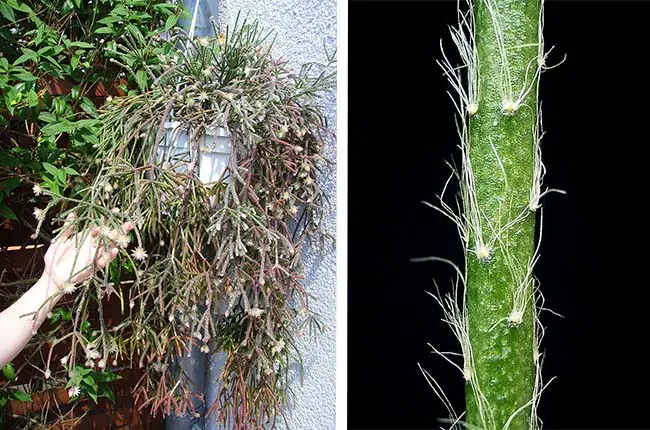
(Gerbil, CC BY-SA 3.0, via Wikimedia Commons)
17. Epiphyllum hookeri (Hooker’s Orchid Cactus)
This is a beautiful climbing cactus with trailing flat and broad leaves that can grow to around 4 feet long (1.2 meters).
Its flowers are large, white, and showy.
18. Epiphyllum creantum (Orchid Cactus)
The Orchid Cactus is a long, trailing plant that naturally grows on trees, and can root itself from cuttings. They need a damp environment around their roots, and usually prefer to trail.
It’s a beautiful epiphytic cactus that produces creamy flowers with amber-ish tips on the outer parts.
These flowers can be a full 11 inches (29 cm) across in diameter, and the stems can reach as much as 2 feet (60 cm) long, and around 2 inches (5 cm) wide.
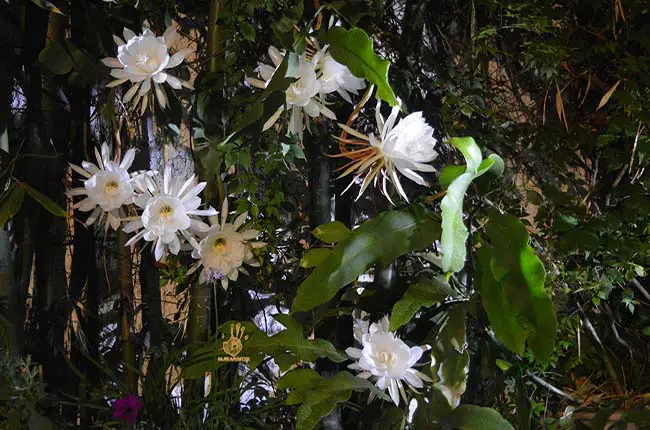
(കാക്കര, CC BY-SA 4.0, via Wikimedia Commons)
19. Selenicereus wittii (The Moonflower)
The Moonflower cactus has broad wavy green leaves. It can drape nicely or climb a surface once it has matured into a big plant, reaching up to 20 feet (6 meters) long.
It is one of the few epiphytic cacti with hair. It produces attractive, creamy flowers, which can reach to around 5 inches (12.5 cm) across.
20. Hylocereus undatus (Dragon-Fruit)
This cactus makes a perfect trailing plant outdoors because it can get quite large and thus needs a good amount of space. Its epiphytic roots will wrap around any suitable surface to support itself.
It can reach over 13 feet (4 meters) in some cases, in both height and spread.
It produces huge beautiful flowers, followed by delicious edible fruits.

(Fronteira, CC BY-SA 4.0, via Wikimedia Commons)
What are epiphytic cacti?
An epiphytic cactus is a member of the cactus family that grows with its roots above the soil, usually by attaching itself to another plant or a rock.
Most epiphytic cacti grow in rainforest regions, often in South and Central American regions, and they may look quite different from the desert cacti you are familiar with.
Several different genera of cacti produce epiphytic versions, including Rhipsalis, Weberocereus, Disocactus, Selenicereus, and Hylocereus.
The term epiphytic means that they grow on the surface of another plant, and get nutrients and moisture from the air, rather than drawing them directly from the soil. They usually take up rainwater and collect nutrients from the debris that collects around their roots.
Some cacti grow this way because it suits the environment that they have adapted to. All cacti like to have plenty of oxygen around their roots and good drainage – and this has caused many to grow in sandy conditions, where water can immediately drain away, and there’s plenty of airflow.
For cacti trying to grow where the soil is too heavy and the drainage is too poor, becoming epiphytic is the obvious next step. This gives them access to a good flow of oxygen over their roots and superb drainage.
Being epiphytic is a cactus’s way of recreating its desired conditions in places where the soil is not hospitable for it. That is why most epiphytic cacti grow in rainforest regions.
The majority of cacti that grow as epiphytes do not have sharp spines, and instead, have elongated leaves to maximize their light-gathering capacities. This is more important than defense in the regions where they grow and therefore is the preferred method.
The features of epiphytic cacti can vary, but most have some means of storing water inside their stems, and many also have a basket-like shape so that they can catch debris to provide themselves with nutrients (such as falling leaves).
They have a high level of seed production because there’s a lower chance of their seeds ending up in the right places in the rainforest.
Related
Do Cacti Like Humidity? (Species List Included)
Top 26 Succulents with Spiky Leaves
Top 10 Little-Known Spiral Cactus Types
13 Stunning Cacti by Flower Color
- Top 6 Drip Irrigation Systems for Raised Beds (2025) - January 31, 2025
- Top 10 Orchid Fertilizers: A Comprehensive Review (2025) - January 16, 2025
- Top 6 Slow-Release Fertilizers for Houseplants & Veggies (2025) - January 15, 2025
